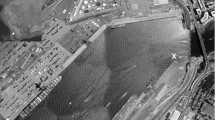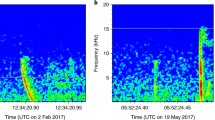Abstract
WITHIN the past three years, whistlers have been heard consistently at a number of stations located on the polar side of the auroral zones. Certain characteristics of polar whistlers have been reported by Martin1 for Scott Base (geomagnetic latitude 79.3° S.), by Ungstrup2 for Godhavn (79.8° N.) and by Helliwell et al. 3 for Byrd Station (70.6° S.). In each case similarities to whistlers received at lower latitudes are noted, which lend support to Martin's suggestion that polar whistlers originate in lower latitudes and are then propagated into the polar regions by reflexion between the Earth and the lower ionosphere. The purpose of this communication is to describe observations showing that lightning sources in middle latitudes can give rise to whistlers heard at polar latitudes.
Similar content being viewed by others
References
Martin, L. H., Nature, 181, 1796 (1958).
Ungstrup, E., Nature, 184, 806 (1959).
Helliwell, R. A., Martin, L. H., and Marks, K., Forty-first Annual Meeting, Amer. Geophys. Union, Washington, D.C. (1960).
Morgan, M. G., and Dinger, H. E., Nature, 177, 29 (1956).
Storey, L. R. O., Phil. Trans. Roy. Soc., A, 246, 113 (1953).
Allcock, G. McK., J. Atmo. Terr. Phys., 14, 185 (1959).
Author information
Authors and Affiliations
Rights and permissions
About this article
Cite this article
ALLCOCK, G. Propagation of Whistlers to Polar Latitudes. Nature 188, 732–733 (1960). https://doi.org/10.1038/188732a0
Issue Date:
DOI: https://doi.org/10.1038/188732a0
- Springer Nature Limited





